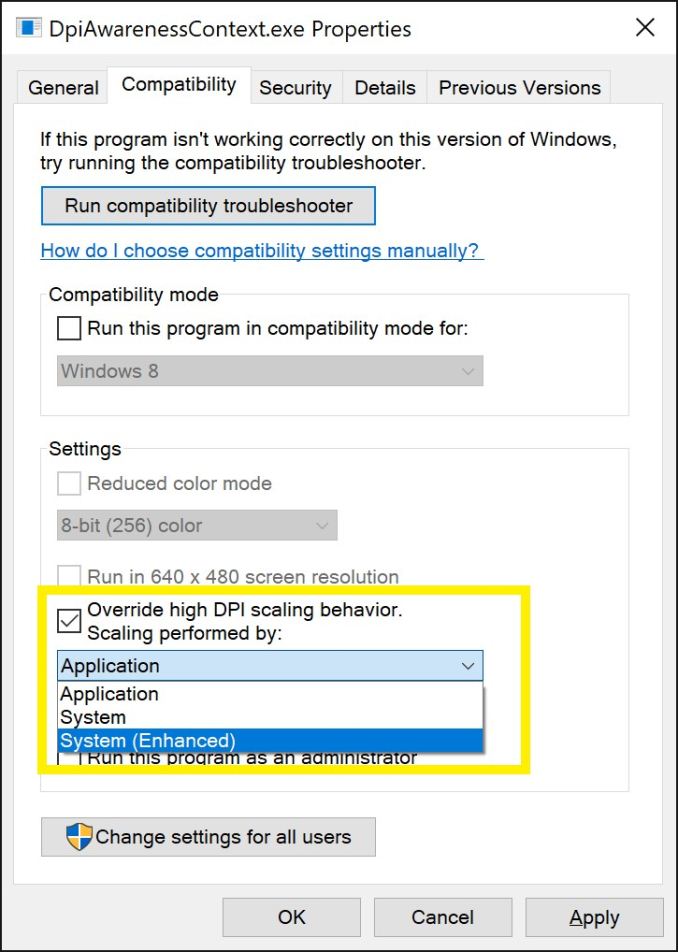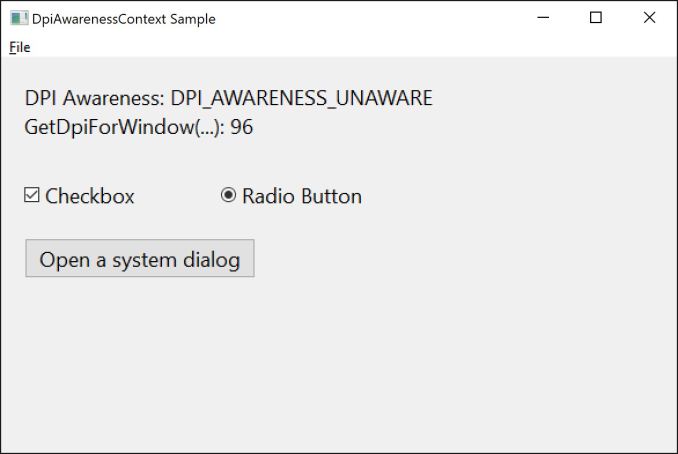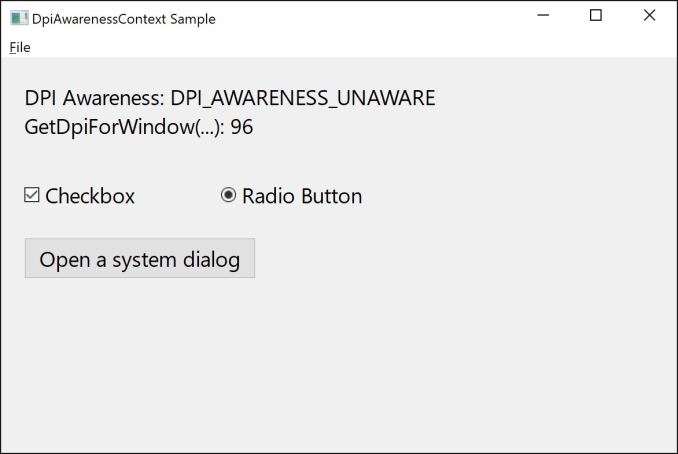The Windows 10 Creators Update Arrives
by Brett Howse on April 25, 2017 8:00 AM EST- Posted in
- Software
- Operating Systems
- Windows
- Microsoft
- Windows 10
High DPI Changes
Although the Mac had a fairly seamless transition to “Retina” displays, Microsoft hasn’t had the luxury of owning the end-to-end product, and as always with Windows, there is a huge backlog of older applications as well. To say the transition to high DPI has been a challenge would be an understatement. They have made some great progress here, but they still have a lot of work to do, and they don’t have the developer buy-in to just add ways for developers to fix their apps either. Any changes here need to benefit the myriad of applications that don’t, and likely never will, support high DPI APIs.
UWP apps are practically exempt from these issues, but the majority of Windows applications are not UWP, and even tools Microsoft has built to help developers bring their apps to the store, such as the Centennial bridge to convert Win32 apps to packaged apps for the store, can’t fix the underlying issues with supporting applications that were built for 96 DPI on displays with double, triple, or even more, DPI.
But that hasn’t stopped Microsoft from making progress. The Anniversary Update brought some nice changes and worked on per-monitor DPI awareness issues, and introduced mixed-mode DPI scaling, and DPI awareness at the process level instead of just the application level.
A graphic showing many of the common issues with High DPI, especially on mulitple different DPI displays
With the Creators Update, they are introducing a new way to handle per-monitor DPI issues, which they have dubbed Per-monitor DPI awareness V2. The new method adds support for child window DPI change notifications, automatically enabled non-client scaling, automatic DPI scaling for dialog boxes, and more control for dialog scaling. All of these are to improve how a developer handles DPI scaling, and especially on a system with multiple monitors with different DPIs, which has been one of the biggest sore spots even as the primary monitor DPI issues have been worked on over the last couple of years. This is an incredibly common scenario too, with a high-resolution laptop docked to a standard resolution display, for example.
Win32 clearly has a lot of baggage to deal with, but hopefully we will continue to see API improvements in Windows 10 updates to keep chipping away at these issues. However, this assumes that a developer is actually going to update their application. That may never happen.
When looking at this issue three years ago when we looked at DPI issues in Windows, one of the conclusions was that Windows has to stop expecting applications to behave correctly. There needed to be an override on the exe to force it to be scaled by Windows, since many applications were claiming to be DPI aware, when they were not at all. If the application could be set to ignore this flag, at least Windows would be able to scale it using bitmap stretching. It wouldn’t be ideal, but it could perhaps make the application useable when it would otherwise not be.
Microsoft has somewhat addressed this, with a new setting in the application compatibility called System (enhanced) DPI scaling. This new setting has some limitations, but is effective enough that Microsoft is using it for some built-in applications. Functionality is limited to GDI-based applications and it won’t correctly scale GDI+ content, DX content, or bitmap content, so it may have limited appeal. End users will have to try this on any application they are having DPI issues with to see if it helps.
But when it does help, it helps a lot. Microsoft is using this new scaling method to fix the Microsoft Management Console (mmc.exe) which means the device manager, and more, will be scaled correctly in the Creators Update. Here’s a screenshot of the differences.
Enhanced Scaling OFF
Enhanced Scaling ON
If the application is mostly text based, it could be improved quite a bit with the new mode. It’s not going to solve all applications from having issues, but it’s a nice step in the right direction.
They have also fixed desktop icons being scaled incorrectly if running in a mixed monitor environment.
Microsoft acknowledges there is still work to be done here, especially in the mixed monitor scenario. They are looking at having the Display Settings section show displays in their physical size rather than resolution, which would help a lot if you have a low-resolution monitor that’s larger than a high-resolution monitor, and it makes dragging windows between them difficult. They would also like to address the weird giant windows you get dragging windows from a high DPI display to a low DPI display. There is more coming as well, so stay tuned.














69 Comments
View All Comments
EricaSplash - Friday, April 28, 2017 - link
when will they learn that one friggin place for settings is a lot better than two? Just go back to the old control panel for F's sakemartixy - Friday, April 28, 2017 - link
WSL is good stuff. So Woot.TheUsual - Saturday, April 29, 2017 - link
I'd definitely like to disable updates/restarts while the computer is hibernated.ricster7227@gmail.com - Saturday, April 29, 2017 - link
I have had a number of software compatibility issues with this upgrade. On my desktop the MS Windows Media Player is no longer usable for files not purchased via MS, legacy programs of several types are no longer supported and there are a number of problems that were addressed in new updates that were posted after MS found out they had Screwed Up! I have been on Win 10 for over two years! I just formatted my SSD and am now running Win 7 Pro. It would appear that MS is returning back to their unfriendly stance that has dominated their history! Beware!lanceton - Saturday, April 29, 2017 - link
This update broke many apps for me so I rolled it back.h4rm0ny - Sunday, April 30, 2017 - link
>>"this version has less big features,"So by "less big" you mean "smaller"? :D :D
Or do you mean fewer big features? :D
Jaybus - Monday, May 1, 2017 - link
That many/some legacy apps don't work with high DPI displays cannot be blamed on Microsoft alone. The WM_DISPLAYCHANGE windows message, which supplies both screen resolution and color depth, has been available in the win32 API since Windows 2000, so it certainly isn't their fault that these legacy apps don't bother to scale their windows to fit the screen size.mrvco - Tuesday, May 2, 2017 - link
Being that I self-identify as a marketing genius, my recommendation to Microsoft would be that they start naming their OS releases after burrowing mammals. e.g. Mole, Pocket Gopher, Great Gerbil, Groundhog, Vole, Prairie Dog, etc.snapch23 - Friday, December 29, 2017 - link
We have make it so simple to get the movie maker for widows 10 at http://moviemakerwindows.com when we how to make the movies in windows.